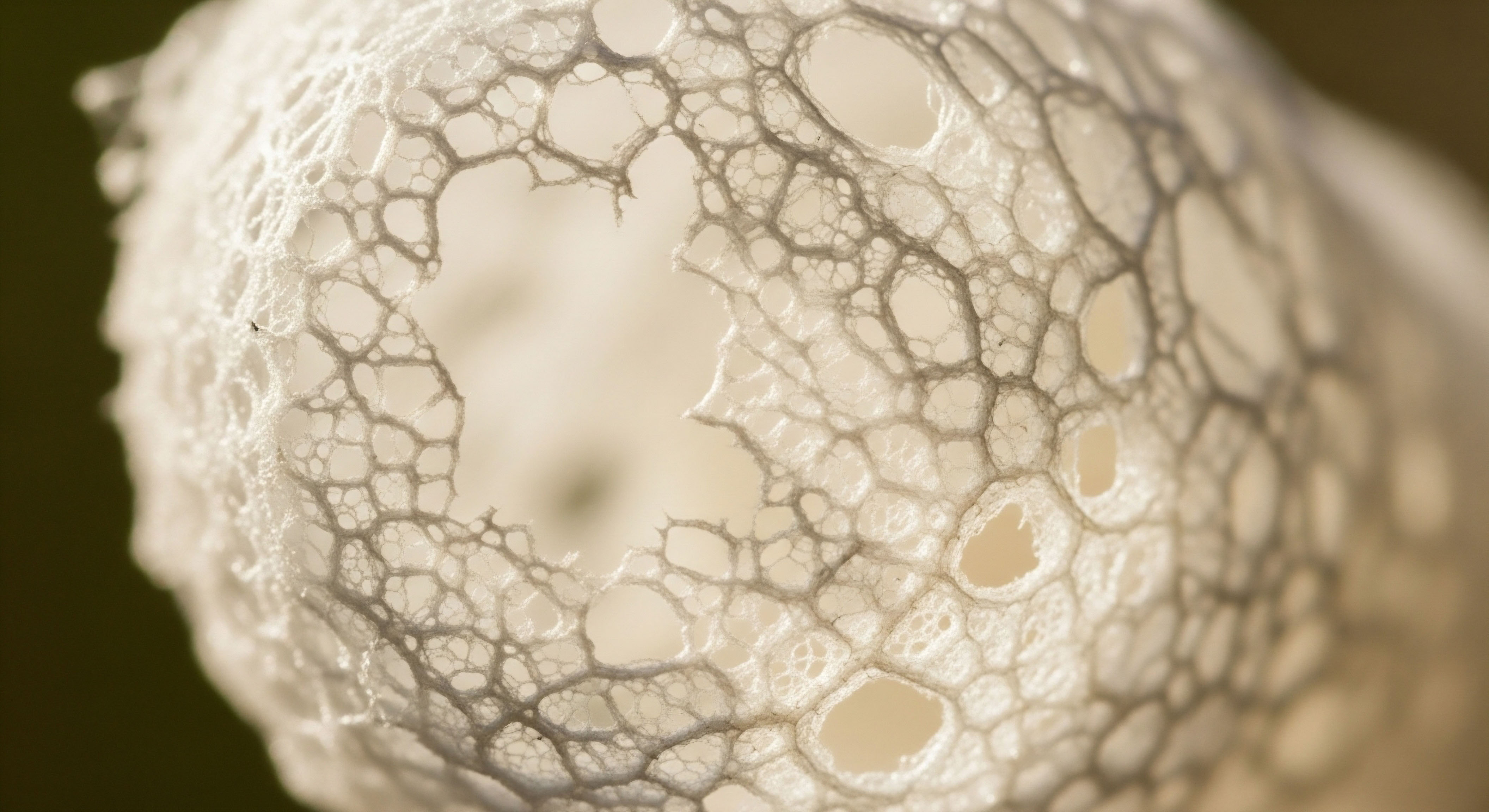

Fundamentals
Embarking on a journey with peptide therapy, such as protocols involving Sermorelin or CJC-1295, often begins with a powerful and deeply personal goal ∞ to reclaim a sense of vitality, to restore the body’s youthful signaling for repair, muscle integrity, and metabolic efficiency.
You may feel the tangible benefits ∞ improved sleep, enhanced recovery, a leaner physique ∞ and these are direct results of recalibrating the body’s growth hormone axis. At the heart of this process is Insulin-like Growth Factor 1 (IGF-1), the primary downstream messenger of growth hormone.
Think of IGF-1 as the body’s master command for cellular growth and regeneration. When growth hormone prompts its release, IGF-1 travels throughout your system, instructing cells to build, repair, and thrive. This is the very mechanism that yields the benefits you seek.
Yet, within this powerful system of renewal lies a delicate biological balance, particularly concerning the prostate. The prostate is a gland uniquely sensitive to growth signals. Its very function and maintenance are tied to hormonal cues. The same potent, pro-growth message that rejuvenates muscle and bone can, in a dysregulated environment, encourage proliferation in prostate tissue.
This brings you to a critical and intelligent question. You are not just asking about a therapy; you are asking about the entire biological system in which that therapy operates. You are seeking to understand how to skillfully conduct the orchestra of your own physiology, ensuring that the powerful music of cellular regeneration plays in perfect harmony with the quiet, steady rhythm of long-term prostate health.
This inquiry moves you from being a passive recipient of a protocol to an active, informed architect of your own well-being.

Understanding the IGF-1 System
The IGF-1 system is a fundamental pillar of human physiology, a complex and elegant network that governs growth from birth through adolescence and shifts to a role of maintenance and repair in adulthood. Growth Hormone (GH), released by the pituitary gland, acts on the liver and other tissues, stimulating the production and secretion of IGF-1.
This molecule then circulates, binding to IGF-1 receptors present on nearly every cell in the body. This binding event triggers a cascade of intracellular signals that promote cell growth, division, and differentiation while simultaneously inhibiting apoptosis, or programmed cell death. In essence, IGF-1 tells your cells, “It is time to grow and fortify.”

The Prostate Gland’s Unique Sensitivity
The prostate gland possesses a high density of receptors for various growth factors, including IGF-1. This sensitivity is a normal part of its biology. During peptide therapy, the intended increase in GH naturally leads to a corresponding rise in circulating IGF-1. The central challenge, therefore, is to ensure this elevated growth signal is properly modulated.
An environment of chronic inflammation, insulin resistance, or an excess of certain dietary precursors can create a state where the prostate becomes overly receptive to IGF-1’s proliferative commands. Supporting prostate health during peptide therapy is about optimizing this environment, ensuring the growth signals are received in a balanced and controlled biological context.
Lifestyle and dietary strategies are essential for modulating how the body utilizes the increased IGF-1 produced during peptide therapy, directly supporting prostate health.
The goal is to create a systemic environment that allows you to reap the anti-aging and regenerative benefits of elevated IGF-1 while simultaneously building a robust defense against its potential to overstimulate prostate tissue. This is achieved by influencing other key players in this system, primarily through precise diet and lifestyle choices that fine-tune your body’s hormonal conversations.


Intermediate
To effectively modulate the IGF-1 system, we must look beyond the single metric of total IGF-1 levels and focus on the factors that govern its bioavailability and cellular impact. This is where targeted diet and lifestyle modifications become indispensable tools.
These interventions work by influencing insulin sensitivity, managing inflammation, and regulating the very proteins that control how much IGF-1 is “free” to interact with receptors in tissues like the prostate. Adopting these strategies allows you to create a biological backdrop that guides the powerful effects of peptide therapy toward regeneration and away from unwanted proliferation.

Dietary Architecture for Hormonal Balance
Your daily nutritional intake provides the foundational building blocks and informational signals that direct your endocrine system. By making conscious choices, you can architect a diet that actively supports prostate health.

The Critical Distinction in Protein Sources
Protein is essential for the muscle synthesis benefits of peptide therapy, yet the source of that protein sends vastly different signals to the IGF-1 pathway. High intake of animal protein, particularly from dairy products, has been shown to significantly increase circulating IGF-1 levels. Plant-based proteins, conversely, do not appear to have the same potent effect on IGF-1 production. This suggests a strategic approach to protein consumption is warranted.
The objective is to provide sufficient amino acids for muscle repair without chronically overstimulating the IGF-1 axis. A diet that emphasizes protein from legumes, nuts, seeds, and whole grains, with controlled and mindful inclusion of lean animal protein, can achieve this balance. This approach provides the resources for recovery while helping to maintain a more stable IGF-1 environment.
| Protein Source Category | Primary Examples | General Impact on IGF-1 | Prostate Health Consideration |
|---|---|---|---|
| Plant-Based Proteins | Lentils, beans, chickpeas, tofu, tempeh, quinoa, nuts, seeds | Minimal to no increase in circulating IGF-1. | Considered highly favorable for creating a stable IGF-1 environment. |
| Lean Animal Proteins | Wild-caught fish, pasture-raised poultry, lean cuts of red meat | Moderate increase in IGF-1. | To be consumed in moderation, balanced with high plant-protein intake. |
| Dairy Proteins | Milk, cheese, whey protein supplements, casein | Significant and potent increase in circulating IGF-1. | Should be minimized or avoided to prevent excessive IGF-1 stimulation. |

Carbohydrate Quality and Insulin Management
The interplay between insulin and IGF-1 is profound. High insulin levels, often driven by a diet rich in refined carbohydrates and sugars, can decrease the production of Insulin-like Growth Factor Binding Proteins (IGFBPs). These binding proteins are crucial; they act like chaperones, binding to IGF-1 in the bloodstream and controlling its availability to cell receptors.
When IGFBP levels are low, more “free” IGF-1 is available to stimulate tissues, including the prostate. Therefore, managing insulin is a primary strategy for modulating IGF-1 activity.
- Focus on Low-Glycemic Foods ∞ Prioritize complex carbohydrates from vegetables, whole fruits, legumes, and whole grains. These foods cause a slower, more controlled release of glucose and insulin.
- Eliminate Refined Carbohydrates ∞ White bread, pastries, sugary drinks, and highly processed foods trigger sharp insulin spikes, which can negatively impact the IGF-1/IGFBP balance.

Lifestyle Interventions the Power of Movement
Physical activity is a powerful modulator of hormonal health, capable of fine-tuning the body’s sensitivity to both insulin and IGF-1. The right type of exercise can enhance the benefits of peptide therapy while building a protective shield for the prostate.
Regular physical activity improves insulin sensitivity and increases IGF-binding proteins, creating a more favorable hormonal environment for prostate health.

How Does Exercise Specifically Modulate Prostate Health Risks?
Exercise initiates a cascade of beneficial physiological changes. It helps reduce visceral fat, a source of inflammatory signals that can contribute to prostate issues. It enhances glucose uptake by muscles, lessening the body’s reliance on high insulin levels. Crucially, specific forms of exercise have been shown to directly alter the IGF-1 axis in a beneficial way.
While intense exercise can cause a temporary, acute spike in IGF-1 (part of the stimulus for muscle growth), consistent training appears to increase the levels of IGFBPs over the long term. This creates a more favorable ratio of bound-to-free IGF-1, which is key for prostate safety.
| Exercise Type | Description | Effect on IGF-1 Axis | Benefit for Prostate Health |
|---|---|---|---|
| Brisk Aerobic Activity | Walking, jogging, cycling, swimming for 30-45 minutes, 3-5 times per week. | Improves insulin sensitivity, may reduce resting IGF-1 over time. | Reduces systemic inflammation and lowers insulin load, creating a less proliferative environment. |
| Resistance Training | Weightlifting, bodyweight exercises, 2-3 times per week. | Causes acute IGF-1 increase for muscle repair but can increase long-term levels of IGFBP-3. | Builds metabolically active muscle and enhances the body’s ability to regulate free IGF-1. |
| High-Intensity Interval Training (HIIT) | Short bursts of maximal effort followed by brief recovery periods. | Potent stimulus for growth hormone release and improved insulin sensitivity. | Time-efficient method to enhance metabolic health and hormonal regulation. |
By integrating these specific dietary and exercise strategies, you are actively participating in your health. You are creating a biological system that is resilient, responsive, and intelligently structured to support both the regenerative goals of peptide therapy and the lifelong health of your prostate.


Academic
The central paradox of utilizing growth hormone secretagogues like Sermorelin or Tesamorelin while simultaneously aiming to protect the prostate lies at the intersection of total versus bioavailable IGF-1. A sophisticated understanding reveals that the therapeutic goal is not simply to suppress IGF-1, but to intelligently manage its activity.
The very lifestyle and dietary modifications often recommended for general wellness are, from a mechanistic standpoint, powerful tools for increasing the expression of Insulin-like Growth Factor Binding Proteins (IGFBPs), particularly IGFBP-1 and IGFBP-3. These proteins are the lynchpin in a strategy that reconciles the use of pro-growth peptides with prostate cellular health.

The Decisive Role of IGF Binding Proteins
The biological activity of IGF-1 is rigorously controlled by a family of six high-affinity binding proteins. Over 95% of circulating IGF-1 is bound to these proteins, primarily IGFBP-3. This binding accomplishes two critical functions ∞ it extends the half-life of IGF-1 in the bloodstream and, most importantly, it restricts its ability to bind with the IGF-1 receptor (IGF-1R) on cell surfaces.
Free, unbound IGF-1 is the primary bioactive component that drives cellular proliferation. Therefore, any strategy that increases the concentration of IGFBPs effectively creates a more robust buffering system, sequestering the increased total IGF-1 produced during peptide therapy and preventing excessive signaling at the prostate tissue level.

How Do Diet and Exercise Directly Influence IGFBPs?
The link between lifestyle choices and IGFBP levels is supported by significant clinical data. Insulin is a primary inhibitor of IGFBP-1 and IGFBP-2 synthesis in the liver. Diets high in refined carbohydrates that provoke hyperinsulinemia directly suppress the levels of these protective binding proteins.
Conversely, a low-glycemic diet that stabilizes insulin levels allows for higher expression of IGFBPs. Physical exercise operates through complementary pathways. Studies have demonstrated that regular, moderate-to-intensive exercise can significantly increase circulating IGFBP-1 levels. Furthermore, long-term resistance training has been correlated with sustained elevations in IGFBP-3. This creates a powerful synergy ∞ peptide therapy increases the total amount of IGF-1, while a disciplined diet and exercise regimen increases the concentration of the proteins that bind and control it.
The sophisticated approach to prostate safety during peptide therapy centers on maximizing IGF-binding proteins to buffer the elevated total IGF-1, thereby controlling its bioavailability.

A Systems-Biology View of Prostate Health
Viewing this from a systems-biology perspective, the prostate does not exist in isolation. Its cellular behavior is a reflection of the systemic milieu. Peptide therapy introduces a strong anabolic and proliferative signal. The strategic lifestyle modifications introduce equally potent regulatory and anti-inflammatory signals. The net effect on the prostate is determined by the integration of these competing inputs.
- Nutrient Sensing Pathways ∞ A diet low in animal protein and refined carbohydrates downregulates the mTOR pathway, a central regulator of cell growth that is highly sensitive to both amino acids (like leucine, abundant in dairy) and insulin. This caloric and protein-source mindfulness complements the IGFBP-enhancing effects.
- Inflammatory Cytokines ∞ Adipose tissue, particularly visceral fat, is a source of pro-inflammatory cytokines like IL-6 and TNF-alpha, which can promote a pro-proliferative environment in the prostate. Exercise and a whole-foods diet reduce adiposity and systemic inflammation, making the prostate tissue less susceptible to aberrant growth signals.
- The Gut-IGF-1-Prostate Axis ∞ Emerging research highlights a connection between the gut microbiome, the production of metabolites like short-chain fatty acids (SCFAs), and the regulation of IGF-1. A diet rich in fiber from diverse plant sources fosters a healthy microbiome, which may represent another layer of systemic modulation influencing IGF-1 production and activity. A high-fiber diet, central to the Mediterranean dietary pattern, supports this axis.
In conclusion, the concern regarding peptide therapy and prostate health is valid, but it is addressable through a sophisticated, evidence-based approach. The strategy involves leveraging diet and exercise not merely as healthy habits, but as targeted biochemical interventions.
Their primary role in this context is to upregulate the body’s endogenous IGF-1 control system ∞ the IGFBPs ∞ and to reduce systemic inflammation and insulin resistance. This creates a physiological state in which the body can benefit from the regenerative potential of increased growth hormone and total IGF-1, while the prostate itself is shielded from overstimulation by a robust network of regulatory proteins and a quiescent inflammatory environment. This is the pinnacle of personalized, proactive medicine ∞ using powerful therapies within an intelligently managed biological system.

References
- Allen, N. E. Key, T. J. Dossus, L. Rinaldi, S. Cust, A. Lukanova, A. & Kaaks, R. (2008). The associations of diet with serum insulin-like growth factor I and its main binding proteins in 292 women in four countries. Cancer Epidemiology and Prevention Biomarkers, 17(7), 1763-1772.
- Haff, G. G. & Triplett, N. T. (Eds.). (2015). Essentials of Strength Training and Conditioning 4th Edition. Human kinetics.
- Shimizu, Y. Kessoku, T. Kobayashi, T. Kajiura, M. Nakajima, A. & Kato, S. (2022). Connecting the Dots Between the Gut ∞ IGF-1 ∞ Prostate Axis ∞ A Role of IGF-1 in Prostate Carcinogenesis. Frontiers in Endocrinology, 13, 851365.
- Barnard, R. J. Ngo, T. H. Leung, P. S. Aronson, W. J. & Golding, L. A. (2003). A low-fat diet and/or strenuous exercise alters the IGF axis in vivo and reduces prostate tumor cell growth in vitro. The Prostate, 56(3), 201 ∞ 206.
- Santa-Cruz, J. M. & Cahan, P. (2021). Emerging Role of IGF-1 in Prostate Cancer ∞ A Promising Biomarker and Therapeutic Target. Cancers, 13(16), 4149.
- Crighton, E. J. & Crighton, M. (2021). Exercise effects on adipokines and the IGF axis in men with prostate cancer treated with androgen deprivation ∞ A randomized study. Journal of cachexia, sarcopenia and muscle, 12(1), 125-133.
- Levine, M. E. Suarez, J. A. Brandhorst, S. Balasubramanian, P. Cheng, C. W. Madia, F. & Longo, V. D. (2014). Low protein intake is associated with a major reduction in IGF-1, cancer, and overall mortality in the 65 and younger but not older population. Cell metabolism, 19(3), 407-417.
- Fuhrman, J. (2018). The Hidden Dangers of Protein. American journal of lifestyle medicine, 12(5), 376 ∞ 381.

Reflection
The information presented here marks the beginning of a deeper dialogue with your own biology. You began with a specific question about safety and efficacy, and have arrived at a more profound understanding of synergy. The human body is a system of systems, where no single intervention acts in a vacuum. The decision to engage with a therapy like growth hormone peptides is a commitment to understanding and supporting the entire physiological landscape.

What Is Your Body’s True Potential for Self Regulation?
Consider the knowledge you have gained not as a list of rules, but as a set of levers. The foods you choose, the way you move your body, the priority you give to rest ∞ these are the primary controls you have to orchestrate your internal environment.
Peptide therapy can be a powerful catalyst for renewal, and its ultimate expression in your body is guided by the daily choices you make. Your path forward is one of conscious integration, a partnership between advanced clinical science and the foundational wisdom of a well-tended lifestyle. This journey is about building a body that is not only resilient and vital but also exquisitely well-managed.



